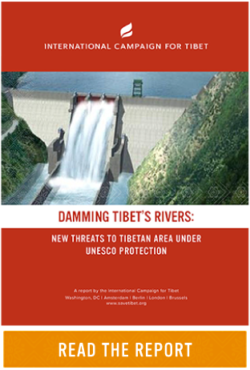- A new report from the International Campaign for Tibet (ICT) reveals the construction of dams and infrastructure in Tibet that will potentially force the relocation of thousands of local people. The report also explains how the dams may impact the biodiverse area of Tibet known as the “Three Parallel Rivers,” which is under UNESCO protection.
- Despite threatening this region, China’s powerful grid and dam industry, led by senior Communist Party officials, sponsored a UNESCO water conference in Paris this month, demonstrating China’s attempts to silence criticism by coopting global institutions.
- The proposed dams and other development projects will help fuel China’s economic growth while deepening human rights and environmental crises in Tibet, one of the most repressed areas on Earth and an epicenter of global climate change.
According to UNESCO, the Three Parallel Rivers region of Tibet is “the last remaining stronghold for an extensive suite of rare and endangered plants and animals.”
But this ecologically vital location, which was named a UNESCO World Heritage site in 2003, faces unprecedented danger from major damming and hydropower projects that Chinese government officials are overseeing while China uses it political and economic clout to undermine UNESCO’s role.
ICT’s new report, “Damming Tibet’s Rivers: New Threats to Tibetan Area under UNESCO Protection,” investigates the effects on the local population and the downstream impact of dams on the UNESCO-protected Three Parallel Rivers site.
The report, released today, features research and analysis showing that several new dams are either under construction or in planning around the unique location where the Yangtze, Mekong and Salween rivers briefly run parallel to one another. The research shows how dams are constructed either upstream or directly next to the protected Three Parallel Rivers area in violation of environmental protection practices and norms.
Land ruined, locals relocated
The Three Parallel Rivers area is one of the world’s most biologically diverse temperate regions. With about 7,000 plant species, it is known as the ‘gene bank of the world’ and was named a UNESCO World Heritage site in 2003.
But Chinese development projects in the region—including not only the dams but also new mining, major infrastructure construction and mass tourism—threaten to erode its landscape and add to the spiraling environmental crisis in Tibet, which is already warming nearly three times faster than the global average.
To make matters worse, Chinese sources say thousands of people will be forced to relocate as a result of the dam construction, including possibly 100,000 people because of the Longpan/Tiger Leaping Gorge dam over the Yangtze River and more than 58,000 people because of hydropower projects in Qinghai Province.
Interference in international bodies
UNESCO has not so far seriously confronted these worrying developments near the Three Parallel Rivers area, and its sensitive relationship with organizations closely linked to the Chinese state is of great concern.
For example, UNESCO’s International Water Conference in Paris on May 13 and 14 was sponsored by the Global Energy Interconnection Development and Cooperation Organization, known as GEIDCO.
GEIDCO, based in Beijing, is led by Chairman Liu Zhenya, former president of the State Grid Corporation of China and alternate member of the 17th Chinese Communist Party central committee.
In addition, former Chinese ambassador to Belgium Xing Qu was appointed deputy director general of UNESCO in March 2018.
The World Hydropower Congress, held in Paris immediately after the UNESCO conference, was organized by the International Hydropower Association. The executive vice president of the association, Liu Chuxue, is also vice president of China’s Three Gorges Corporation, which built one of the world’s most notorious dams that displaced more than 1.2 million people and set records for the number of cities and towns flooded, corruption, human rights violations and environmental degradation.
In its report, ICT joins with other stakeholders to provide a number of recommendations to those who met in Paris this month, including that “No energy facilities that potentially impact the territories and livelihoods of […] traditional communities should be authorized without obtaining the free, prior and informed consent of the community.”
Quote
Kai Mueller, ICT UN advocacy team:
“This report shows the Chinese government’s strategy to seek UNESCO’s endorsements and branding of sites in Tibet, while at the same time bypassing the norms and practices that properly preserve them, is both reckless and dangerous. By building dozens of dams in the Tibetan Plateau that are very near to and affect UNESCO’s protected areas, Beijing is both putting at risk a unique ecosystem and potentially endangering the livelihood of thousands of people. UNESCO must do better to hold the Chinese government accountable and carry out a proper investigation, as UNESCO’s own reputation will also be at risk.”


